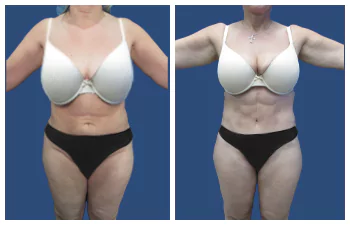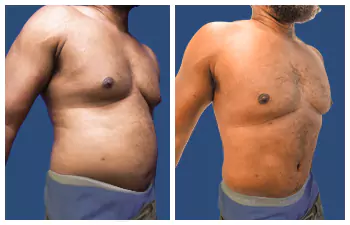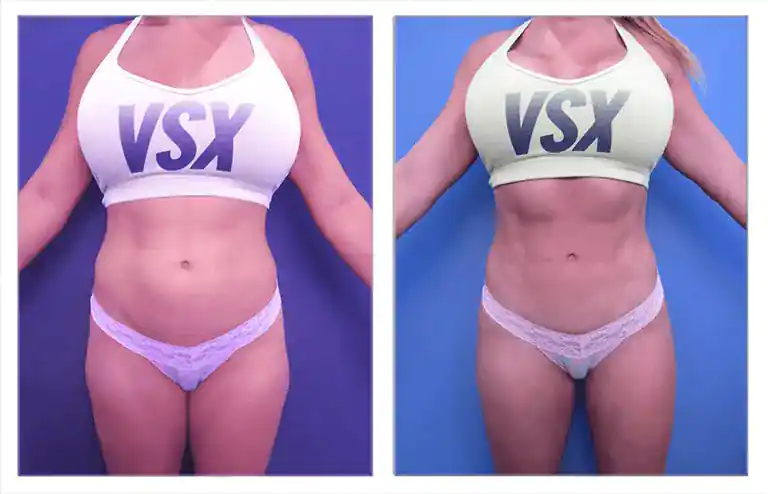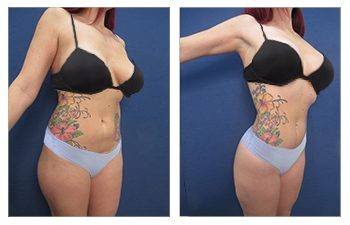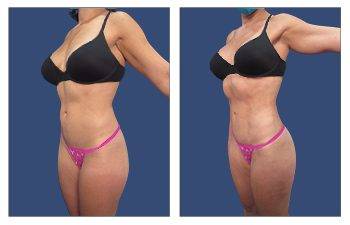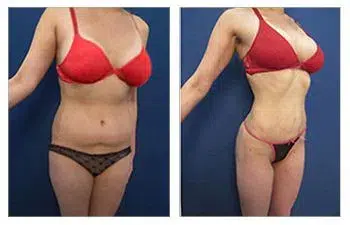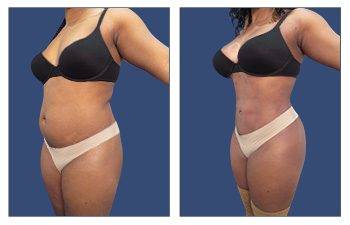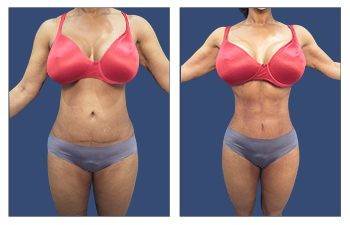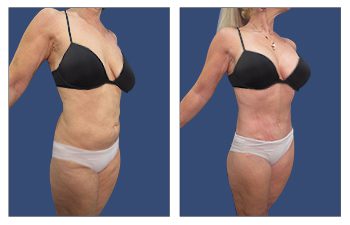Have you ever caught your reflection and wished for a flatter, firmer belly? It’s a common desire that often feels just out of reach. Even after countless crunches, balanced meals, and long hours at the gym, stubborn pockets of fat around the abdomen can persist. A liposuction tummy tuck can help you!
Introduction to Simultaneous Liposuction Tummy Tuck
Cosmetic surgery has witnessed significant advancements, offering individuals various options to enhance their appearance and boost their self-confidence. Two popular procedures that address abdominal concerns are simultaneous liposuction and tummy tuck, also known as lipoabdominoplasty. This blog explores these procedures’ nuances, benefits, risks, and considerations for potential candidates.
The Significance of Abdominal Aesthetics: The abdomen plays a crucial role in overall body aesthetics. Factors such as weight fluctuations, pregnancy, and genetics can lead to excess fat deposits and loose skin in the abdominal area. These changes can negatively impact self-esteem and body image. Simultaneous liposuction and tummy tuck procedures offer a combined approach to tackle these issues, resulting in a more sculpted and contoured abdominal region.
Understanding Simultaneous Liposuction and Tummy Tuck:
- Liposuction: Liposuction is a minimally invasive surgical procedure designed to remove localized fat deposits from various body parts, including the abdomen. It involves making small incisions through which a thin tube (cannula) is inserted to break up and suction out excess fat. Liposuction targets stubborn fat that is resistant to diet and exercise.
- Tummy Tuck (Abdominoplasty): Tummy tuck is a surgical procedure that involves removing excess skin and fat from the abdominal area while tightening the underlying muscles. Different types of tummy tucks, including full, mini, and extended, each catering to specific aesthetic concerns. This procedure is particularly effective for individuals with loose skin and weakened abdominal muscles, often resulting from pregnancy or significant weight loss.
The Synergy of Simultaneous Procedures: Simultaneous liposuction tummy tuck procedures offer a comprehensive approach to body contouring. Combining these procedures allows cosmetic surgeons to address excess fat and sagging skin in a single surgery, leading to enhanced results. Liposuction can sculpt the waistline, flank areas, and the central abdomen, complementing the skin and muscle tightening achieved through the tummy tuck.
Benefits of Simultaneous Liposuction and Tummy Tuck:
- Enhanced Aesthetic Outcomes: Combining liposuction with a tummy tuck allows for better contouring and shaping of the abdominal area, resulting in a more harmonious and balanced appearance.
- Reduced Surgical Sessions: Simultaneous procedures save time and minimize the overall number of surgical sessions, reducing anesthesia exposure and recovery periods.
- Improved Recovery: Despite being a combined approach, the recovery period for simultaneous procedures is often similar to that of a standalone tummy tuck, making it an attractive option for many patients.
- Cost Efficiency: Undergoing both procedures simultaneously can be more cost-effective than having them done separately, as it reduces facility and anesthesia fees.
Considerations and Candidacy: While simultaneous liposuction and tummy tuck offer numerous benefits, they may not be suitable for everyone. Cosmetic surgeons carefully assess each candidate’s medical history, health status, and aesthetic goals to determine candidacy. Ideal candidates typically include individuals who:
- Are in good general health and do not have significant medical conditions that could complicate surgery.
- Have realistic expectations about the outcomes of the procedures.
- Have excess fat deposits and loose skin in the abdominal area.
- Are at a stable weight and committed to maintaining a healthy lifestyle.
- Are non-smokers, as smoking can hinder the healing process.
Potential Risks and Complications: Simultaneous liposuction tummy tuck procedures have a unique potential risk of vascular compromise. The potential for vascular compromise following this procedure can only be appreciated by understanding the blood flow to the abdominal soft tissues. Vascularity to the soft tissues follows two routes that include horizontal and vertical blood flow.
As the name describes, vertical flow occurs through perforator vessels extending from the body’s main blood vessel, called the aorta. Undermined areas will have this vertical blood flow compromised during a tummy tuck procedure. Horizontal blood flow describes blood flow that spreads across the body through a horizontal web of microvessels called the subdermal plexus.
Liposuction, which involves the elimination of fat from the soft tissues, affects the horizontal blood flow. As such, performing liposuction and a tummy tuck simultaneously must consider these limitations. To safely perform these procedures simultaneously, it is important to design areas for proposed liposuction versus areas requiring strategic undermining so they do not overlap.
The modified abdominal skin resection
The modified abdominal skin resection is a proprietary procedure pioneered at our institution to safely provide the ability to perform simultaneous liposuction tummy tuck procedures. The undermining area is limited to eliminate skin redundancy while avoiding areas for planned liposuction.
As such, the modified abdominal skin resection is a modification of traditional liposuction techniques to achieve superior abdominal contouring results. The modified abdominal skin resection maximizes skin resecting while creating natural shadows and even muscle highlights over the abdominal region. The modified abdominal skin resection results are superior to conventional techniques previously described for abdominal contouring.
Conclusion: Simultaneous liposuction tummy tuck represents a comprehensive approach to achieving a sculpted and contoured abdominal area. This procedure, coined as the modified abdominal skin resection, offers enhanced aesthetic outcomes, reduced recovery times, and cost efficiency, making it an attractive option for individuals seeking to address excess fat and loose skin.
As with any surgical procedure, careful consideration of candidacy, risks, and benefits is essential. Consulting with a board-certified cosmetic surgeon is the first step towards making an informed decision about these transformative procedures.
Welcome to an enlightening exploration of body contouring solutions: Liposuction tummy tuck. This power combo tackles excess fat and sagging skin – like two sides of the same coin! Whether it’s lingering baby weight or consequences from quick weight loss, these procedures could be your golden ticket to achieving that desired sleek silhouette.
In this journey, we’ll delve into everything you need to know about these transformative treatments – from understanding what they entail to assessing if you are an ideal candidate. We will also discuss recovery times so you can plan. Are you ready
Table Of Contents:
- Understanding Liposuction and Tummy Tuck Procedures
- Benefits of Simultaneous Liposuction and Tummy Tuck
- Who is a Good Candidate for Simultaneous Liposuction and Tummy Tuck?
- The Procedure: What to Expect
- Recovery and Aftercare
- Risks and Complications
- FAQs about Liposuction Tummy Tuck
Understanding Liposuction and Tummy Tuck Procedures
Liposuction and tummy tucks are popular plastic surgery procedures. Both aim to improve body contours, but they target different concerns.
Liposuction procedure, also known as lipo, is a minimally invasive surgical treatment that targets stubborn pockets of fat. The magic happens through small incisions where a thin tube called a cannula removes excess fat from specific body areas permanently. Think about it like vacuuming away those frustrating love handles or muffin tops you’ve spent hours trying to exercise off. A key stat here: liposuction is not an overall weight-loss method, nor does it treat obesity; rather, it’s perfect for removing localized fat deposits—liposuction pricing.
The Artistry Behind the Tummy Tuck Procedure
A tummy tuck goes by its formal name – abdominoplasty. It’s like hiring your sculptor who can help craft your ideal waistline. This surgical procedure removes excess skin (not just fats) from the abdomen and tightens loose abdominal muscles.
Essentially, this operation restores a flatter belly—especially beneficial if you’re dealing with post-pregnancy sagging or have undergone significant weight loss, leaving behind extra skin waving hello.
The Key Differences Between Liposuctions & Tummy Tucks
To clarify any confusion between these two procedures, both aim at enhancing our bodies’ shape—but they do so differently.
- Liposuction primarily focuses on removing fat deposits. It’s akin to chiseling away at a marble block, targeting areas that diet and exercise stubbornly refuse to touch.
- On the other hand, a tummy tuck is more of an ‘overhaul’ for your abdomen—it deals with excess skin and repairs stretched or separated abdominal muscles. Picture it as resetting your belly back to its natural state.
So, if you’re exploring these procedures because of your weight loss goals,
Benefits of Simultaneous Liposuction and Tummy Tuck
If you aim for a sleeker, more contoured body shape, combining liposuction and tummy tuck procedures could be your ticket to achieving that desired result. Both techniques serve unique purposes in the realm of body contouring.
The Synergy of Liposuction and Tummy Tuck
Liposuction excels at spot-reduction of exercise-resistant fat stores. Particularly around the stomach area, where they often develop. But what about excess skin left behind after weight loss or pregnancy? That’s where a tummy tuck steps in.
A tummy tuck aims to restore a flatter, tighter abdominal area by removing this excess skin. When performed together, these two treatments can enhance each other’s effects – giving patients an even more refined silhouette than either procedure could achieve.
While liposuctions effectively remove stubborn pockets of fat from specific areas, they cannot address loose or sagging skin issues; likewise, while a tummy-tuck removes excess skin efficiently, it doesn’t directly handle isolated fatty deposits, which is why simultaneous execution leads to optimal results.
This tandem approach allows plastic surgeons to create smoother transitions between treated areas, resulting in natural-looking contours instead of having odd bulges or irregularities that may occur if done separately due to a lack of coherence during separate sessions.
Faster Recovery Time with Combined Procedures
An additional benefit lies within recovery times. Patients typically require less overall downtime when undergoing both procedures simultaneously compared to those who choose to have them separately because the same general anesthesia is used, minimizing risks associated with repeated exposure and reducing time spent in the operating room.
Though recovery time can vary, factors such as overall health, the extent of the procedures, and adherence to post-operative care instructions will play a role in determining how much downtime is needed. So, while liposuction might require only two days off work with light physical activity, a tummy tuck could necessitate up to 3 weeks for the same.
A Single Surgery Equals Cost Savings
And finally,
Who is a Good Candidate for Simultaneous Liposuction and Tummy Tuck?
Are you close to your ideal body weight but struggling with stubborn pockets of fat around the abdominal area? Or maybe you’ve lost significant weight, leaving behind sagging skin that no amount of gym time seems to fix. If either scenario rings true, then liposuction and tummy tuck procedures could be just what you need.
Liposuction works wonders in removing excess fat. But it’s crucial to note that this procedure isn’t about shedding pounds. It’s recommended for individuals who maintain good overall health within a reasonable range of their ideal body weight. These are folks who have exercise-resistant stores typically developing around the stomach.
A tummy tuck, on the other hand, deals with sagging skin or what we often refer to as ‘paunch’. Individuals sporting one might find this procedure useful in restoring a flatter and tighter abdominal area. Like liposuction candidates, they should also be near their ideal body weight while maintaining good overall health.
The Power Duo: Liposuction and Tummy Tuck
Simultaneously undergoing both procedures can lead to enhanced results in certain cases – think ultimate transformation. Combining them helps remove excess fat and deal with loose skin effectively, which each alone cannot accomplish entirely.
If performed by an experienced plastic surgeon from the SurgiSculpt team – wink wink -, simultaneous procedures ensure uniformity, leading to more natural-looking contours. Plus, there’s the added benefit of a single recovery period instead of two separate ones if done individually.
Your Health Comes First
Before getting too enthusiastic about the potential outcomes, ensuring you’re a suitable candidate for these treatments is important. In addition to being close to your ideal body weight and in overall good health, surgeons will consider other factors like skin elasticity and medical history.
If you have any existing health conditions, such as diabetes or heart disease, your surgeon may require a more thorough assessment before surgery. And if you smoke, brace yourself for some extra motivation chats.
The Procedure: What to Expect
Embarking on a journey towards body transformation through liposuction and tummy tuck is no small feat. Feeling curious or even a tad anxious about what the procedures entail is normal. Here, we will guide you through each step of the process.
Liposuction Techniques
In liposuction, an expert surgeon makes small incisions, often hidden in natural skin folds for minimal scarring. A cannula (thin tube) prevents unwanted fat deposits through these access points.
Different techniques offer unique benefits depending on your specific needs and goals. For instance, SmartLipo uses laser technology that removes excess fat and tightens the skin by promoting collagen production.
Vaser Lipo employs ultrasound waves to liquefy fat before removal. At the same time, Tumescent Liposuction involves injecting large volumes of diluted local anesthesia into fatty tissue, which swells up, making extraction easier.
The Tummy Tuck Process
A tummy tuck goes one step beyond lipo—it addresses excess skin and stretched abdominal muscles under general anesthesia.
This procedure typically begins with an incision made low across the abdomen from hip bone to hip bone – this allows your surgeon access to repair those stubborn abdominal muscles, giving them their toned appearance back.
You’ll be amazed at how flat your stomach can look when the sagging skin is gone. Remember, though, after surgery, you’ll need some time off work—around 2-3 weeks—to recover properly. Compression garments will become part of your wardrobe during recovery. These garments are not just a fashion statement—they’re essential for minimizing swelling and improving contour.
Outpatient treatments can normally be performed, allowing you to recover at the convenience of your residence. But remember, it’s vital that you have someone available to drive you back after the procedure—safety first.
Recovery Time
Both methods are involved, but they each bring something unique to the table. It’s about finding what works best for you.
Recovery and Aftercare
Undergoing liposuction or a tummy tuck is the start of your body transformation journey. The real work begins during recovery.
Liposuction Recovery
The recovery process after liposuction can be as unique as you are. Some common experiences include swelling at the fat removal site, which usually subsides within 1-2 weeks.
You’ll also need to limit physical activity initially, but don’t worry – this isn’t forever. Most patients return to high-impact exercise after 2-3 weeks (Mayo Clinic).
Compression Garments Post-Lipo
Wearing compression garments is key to help reduce swelling and support healing tissues. These specially designed pieces apply pressure in all the right places while letting your skin breathe. Plus, they offer some extra comfort when everything feels a bit tender.
Tummy Tuck Recovery
A tummy tuck involves more intensive surgery than liposuction, so it naturally requires a longer recovery time – typically around six weeks for most people before fully returning to normal activities.
Pain management will likely involve medication prescribed by your doctor; always follow instructions carefully to avoid complications.
Dressing Changes and Compression Wear
Your surgeon may have placed surgical dressings on incisions post-surgery that need changing regularly – it’s essential not only for hygiene reasons but also to help prevent infection. Wearing compression garments can initially feel like getting hugged by an octopus because they’re tight. But remember, they’re crucial in reducing swelling and supporting your newly sculpted abdominal area.
Remember that a full return to high-impact exercise after a tummy tuck typically takes 2-3 months. This might seem like an eternity when you’re itching to show off your new body at the gym, but patience is key. Rushing things can lead to complications or less-than-ideal results.
Rest assured, though; this downtime will be worth it when you finally reveal the tighter, flatter abdomen you’ve been dreaming of.
Risks and Complications
While liposuction and tummy tuck surgeries are generally safe, they come with potential risks, like all surgical procedures. Let’s be bold about it: Complications can happen.
The primary concerns include infection, bleeding, or reaction to anesthesia. These events are rare but still a part of the conversation we need to have.
Liposuction Risks
With liposuction specifically, there may be contour irregularities – your skin might appear bumpy or wavy due to uneven fat removal. In some cases, damage beneath the skin from the thin tube (cannula) used during liposuction could give your skin a permanent spotted appearance.
Potential for nerve damage also exists, leading to numbness in certain areas post-surgery (source).
Tummy Tuck Risks
Moving onto tummy tucks – fluid accumulation is one concern where temporary pockets of fluid called seromas may form under your skin, but these usually improve over time without treatment.
A more serious complication would be tissue necrosis, where fatty tissues deep within your abdomen get damaged during surgery and die off (gross, right? But hey. You asked).
Surgical Scars & Emotional Impact
There is no sugar-coating here, folks – both procedures will leave scars that fade over time but won’t completely disappear. You must be mentally prepared for this change because emotional health matters.
Managing Risks
To reduce these risks, it is important to select a qualified surgeon with experience in the procedures and adhere to all pre- and post-operative instructions. First, choosing a board-certified plastic surgeon with experience in liposuction and tummy tucks is crucial. Second, follow all pre-and post-operative instructions – this means no cheating on recovery time or physical activity limitations.
Potential Long-term Complications
Beyond immediate surgical complications, there could be long-term effects, such as changes in skin sensation that may become permanent.
Don’t overlook the chance of not being happy with how things look in the end – keeping your expectations grounded is key.
FAQs about Liposuction Tummy Tuck
Can you get a tummy tuck and lipo at the same time?
Yes, combining liposuction with a tummy tuck is common. This duo helps remove excess fat and skin for better body contouring results.
Do you lose weight with tummy tuck and lipo?
Tummy tucks and liposuction aren’t weight loss solutions but body contouring procedures. They help eliminate stubborn fat pockets and tighten loose skin to enhance your figure.
How much weight is lost after a tummy tuck and lipo?
The exact amount varies per person, as these surgeries aim to improve shape rather than shedding pounds. On average, patients might drop 2-5 lbs from both procedures combined.
How painful is a Tummy Tuck with Liposuction?
You’ll feel some discomfort post-surgery due to swelling or bruising. But don’t fret. Pain management methods are available to make recovery smoother for you.



